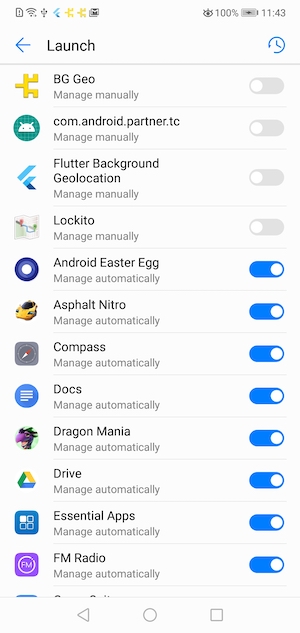- The search index is not available
Returns true if device is ignoring battery optimizations for your app.
In most cases, the Background Geolocation SDK will perform normally with battery optimizations.

This method is designed to be executed from a showPowerManager or showIgnoreBatteryOptimizations callback.
Shows the Android Ignore Battery Optimizations settings screen.
Note: In most cases, the plugin will perform normally with battery optimizations. You should only instruct the user to Ignore Battery Optimizations for your app as a last resort to resolve issues with background operation.

WARNING: Ignoring battery optimizations will cause your app to consume much more power.
showIgnoreBatteryOptimizations does not immediately redirect to the desired Device settings screen. Instead, it first returns a DeviceSettingsRequest, containing
meta-data about the device (manufacturer, model, version), in addition to a flags seen and lastSeenAt, letting you know if and when you've already shown this screen to the user.
In your success-callback, it's completely up to you to instruct the user what exactly to do on that screen.
Based upon the manufacturer/model/os, a Device may not have this particular Settings screen implemented. In this case, catch will fire.
Shows a vendor-specific "Power Management" screen.
For example, a Huawei device will show the Battery->Launch screen:


The site Don't Kill My App provides a comprehensive list of poor Android vendors which throttle background-services that this plugin relies upon.
showPowerManager does not immediately redirect to the desired Device settings screen. Instead, it first returns a DeviceSettingsRequest, containing
meta-data about the device (manufacturer, model, version), in addition to a flags seen and lastSeenAt, letting you know if and when you've already shown this screen to the user.
Unfortunately, there's no possible way to determine if the user actually performs the desired action to "white list" your app on the shown settings-screen. For this reason, you'll have to evaluate the provided properties DeviceSettingsRequest.seen & DeviceSettingsRequest.lastSeenAt and determine for yourself whether to DeviceSettings.show this screen.
In your success-callback, it's completely up to you to instruct the user what exactly to do on that screen, based upon the provided DeviceSettingsRequest properties manufacturer, model and version.
Note: Based upon the manufacturer / model / OS version, a Device may not have a particular Settings screen implemented (eg: Google Pixel). In this case, the Promise will fire an exception.
BackgroundGeolocation.deviceSettings.showPowerManager().then((request:DeviceSettingsRequest) => {
console.log(`- Screen seen? ${request.seen} ${request.lastSeenAt}`);
console.log(`- Device: ${request.manufacturer} ${request.model} ${request.version}`);
// If we've already shown this screen to the user, we don't want to annoy them.
if (request.seen) {
return;
}
// It's your responsibility to instruct the user what exactly
// to do here, perhaps with a Confirm Dialog:
showMyConfirmDialog({
title: "Device Power Management",
text: "Please white-list the app in your Device's Power Management settings by clicking this then selecting that."
}).then((confirmed) => {
if (confirmed) {
// User clicked [Confirm] button. Execute the redirect to settings screen:
BackgroundGeolocation.deviceSettings.show(request);
}
});
}).catch((error) => {
// Depending on Manufacturer/Model/OS Version, a Device may not implement
// a particular Settings screen.
console.log(error);
});
The following Android Settings screen will be shown depending on Vendor / OS version:
| Vendor | Settings Activity Name |
|---|---|
| LeEco | AutobootManageActivity |
| Huawei | StartupAppControlActivity,StartupAppControlActivity (depends on OS version) |
| Color OS | StartupAppListActivity |
| OPPO | StartupAppListActivity |
| Vivo | BgStartUpManagerActivity,AddWhiteListActivity,BgStartUpManager (depends on OS version) |
| Samsung | BatteryActivity |
| HTC | LandingPageActivity |
| Asus | AutobootManageActivity |
| LeEco | mobilemanager.MainActivity |
Generated using TypeDoc
Device Settings API.
Provides an API to show Android & vendor-specific Battery / Power Management settings screens that can affect performance of the Background Geolocation SDK on various devices.
The site Don't Kill My App provides a comprehensive list of poor Android vendors which throttle background-services that this plugin relies upon.
This
DeviceSettingsAPI is an attempt to provide resources to direct the user to the appropriate vendor-specific settings screen to resolve issues with background operation.